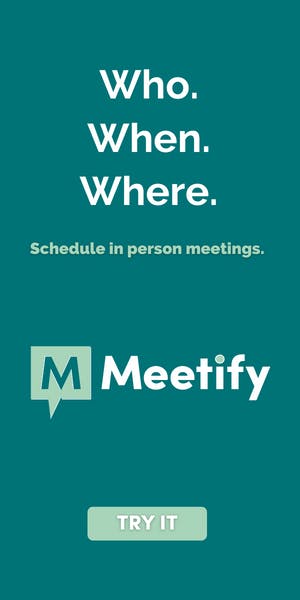
Navigating Customer Discovery
A Revealing Journey for Our Tech Product
Angel Rutledge
Co-founder, Meetify
I previously shared that the idea for Meetify came as a result of the pandemic showing all of us how important relationships are. Being isolated from one another revealed how much better life is when we get those moments to connect in person, often over a meal or coffee.
But we also found the process of scheduling in person meetings to be so inefficient, many of us don’t get together. We thought if we could make the process easier we might all get together more often.
But we didn’t build Meetify from there. We did some customer discovery first. I’ve laid out Tips and Questions for Customer Discovery in our resources section, and I thought it might be helpful to hear how we walked through the process for Meetify.
Customer Discovery Hypothesis
Before we even thought about customer discovery, we researched the market to see if there were already other products that would solve the problem of scheduling in person meetings. We were surprised not to find any that were designed to help figure out where to meet since there are so many that help decide when to meet.
So, I started customer discovery with a hypothesis.
Meeting planners who schedule in person meetings at coffee shops, restaurants and breweries face a frustrating process because there are no meeting schedulers designed to help choose best times AND find ideal locations that are central to all meeting attendees. They would pay a monthly fee to have an easy tool to avoid the back and forth hassle of scheduling in person meetings because it would help them book more meetings, build better relationships with their invitees and accomplish their meeting goals faster.
Customer Discovery Interviews
First, I decided to do some interviews to gather data about my hypothesis. These were the main questions I set out to get answered.
1. Who plans and gets invited to in person meetings held outside of the home and office?
2. How do they currently go about booking them?
3. What still frustrates them about the tools and methods they’re using?
4. How valuable would it be to them for the process to be better than it is now?
5. What would it mean for the process of scheduling in person meet ups at coffee shops, restaurants and breweries to be “better?”
Initially, I thought I’d do about 20-25 in person interviews to collect customer discovery data. Then, I figured, I’d decide whether to keep going with interviews, switch to a survey or if the data was already really clear, I’d compile the results to help us make some decisions.
These were the initial interview questions I used for the in person interviews.
Customer Discovery Interview Questions
1. In what professional or volunteer roles do you meet with people in person, away from home or work?
2. How many (professional and personal) meetings on average do you attend per week, including in person and virtual meetings?
3. What percentage of these meetings are in person at a location away from your home and office?
4. Who sets up the majority of the meetings you attend?
5. What methods or tools are most often used to organize those meetings?
6. Describe the process you followed the last time you scheduled an in person meeting with someone.
7. What parts of organizing that meeting were challenging?
8. Why were these parts challenging?
9. If you had a magic wand, what would you improve about your current method for organizing in person meetings?
10. What software tools would you have trouble living without?
11. How much do you spend on average for each software tool you couldn’t live without?
I used these questions for a handful of in person interviews, but it was the first opportunity I’d had since the pandemic to see the people I was interviewing, so our interactions for customer discovery were disjointed at best. Those I interviewed also really wanted to hear about the company, which I knew would not be ideal to discuss at the customer discovery phase, so I quickly decided to transition to a survey of professionals I didn’t know.
Customer Discovery Survey
For the survey, I wanted to find a random sampling of 100 professionals. I researched online and decided to go with Pollfish for my consumer insights tool since they have a DIY platform, and I could get the surveys completed from the type of audience I wanted to poll in an afternoon for only a few hundred dollars.
Since I was already paying for the survey, I decided to add on several questions that would provide data I might be able to use for some content marketing as well. Here were the customer discovery survey questions I used. They were all multiple choice questions except where I’ve noted it.
1. Do you currently work remotely, on site, or a hybrid of both?
2. In what professional and/or volunteer roles do you meet with others in person, away from home and work? (Short answer)
3. What percentage of the meetings that you attend for work are in person at a location away from your home and office?
4. How many times on average per week do you meet with someone for a volunteer or social related reason?
5. What percentage of all your volunteer and social related meetings are in person at a location away from your home and office?
6. Who schedules the majority of meetings you attend?
7. What software tools or other methods are most often used to organize your meetings? (Short answer)
8. What parts of organizing an in person meeting are challenging? (Check all that apply from 9 options)
9. Rank the following motivations for scheduling an in person meeting, rather than a virtual meeting, from the most important motivation to the least. (Provided 9 options)
10. Rank the following motivations for scheduling a virtual meeting, rather than an in person meeting, from the most important motivation to least. (Provided 9 options)
11. This next set of questions was multiple choice with these options: in person, virtually, either, neither
12. I am more likely to accomplish all the goals I have set for a meeting when I meet_____.
13. I am more likely to enjoy meeting ______.
14. I tend to have a more positive outlook on life when the majority of my meetings are_____.
15. I prefer meeting virtually when the main goal of the meeting is to ____. (Check all that apply from 10 options)
16. I prefer meeting in person when the main goal of the meeting is to ____. (Check all that apply from 10 options)
17. When meeting with someone in person, I prefer to meet _____ (Provided 8 location options, with restaurants and coffee shops being two of them.
18. Rank the following features you need in a software tool to schedule meetings. (Provided 10) options)
19. When choosing a software tool to schedule meetings, I prefer a free tool with advertising/paid subscription with no advertising. (Multiple choice from those 2 options)
When the data came back, I was really glad I’d gone the route of the survey and getting anonymous input. It gave me more confidence than doing the in person interviews that I was getting accurate data, which confirmed our hypothesis. It also helped us see that the core problem we wanted to solve with helping meeting planners figure out the where and when to meet in person was really the fundamental problem that frustrates professionals. One thing I was surprised and excited to see was how high the percentage of people was who said they’d prefer to pay a subscription fee to use the tool with no ads over using it free with ads.
The Minimally Viable Product
The best part about customer discovery is that it so naturally flows into creating the minimum viable product (MVP). From what we discovered through our customer discovery process, we were able to confirm our initial hypothesis and make decisions about the limited features we'd offer in our MVP as well as the business model we thought would work best. We were also able to get a good sense for what some of the features would be that we’d need to add right after launching the MVP.
Looking back, I feel pretty good about the process overall. One thing I’d do differently is create a product mockup with a design tool like Figma to show a group of 10-20 people after doing the survey. It would show the process we envisioned to create a meeting invite and let them walk through it while I watched and listened to their feedback. This would have given us really helpful feedback about how best to design the flow before spending time on the build.
The Customer Discover Process on Repeat
The good news with customer discovery is that it never really ends, so we can continually improve the process. In that sense, the entire life cycle of a product led growth company involves repeating a customer discovery process over and over. The best part after launching the MVP is that we get realtime data from customers as they use the tool, and we can study it to see how they use it and where they stop using it. Even better, we can listen to what customers tell us. No doubt, it can be a humbling process at times, but keeping in mind that we're here to create a solution that will allow people to develop better relationships helps us get over ourselves.
Now that the tool has been live for several months, we've been able to see where changes are needed in the user interface. Updates are in the works now, and we're looking forward to starting the next cycle of customer discovery once the updates go live.


© 2025 Meetify. All rights reserved.
Privacy Policy Terms of ServiceWe use cookies to help you have the best experience using Meetify. Click "Accept All" to consent to our use of cookies. Privacy Policy


